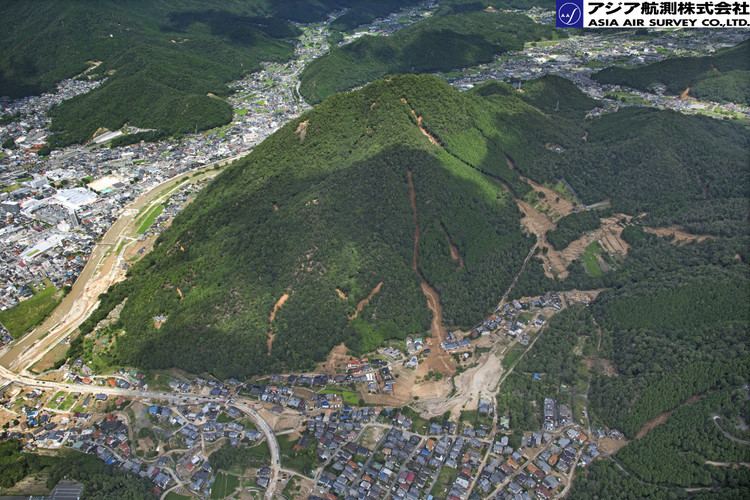Non-fatal injuries 69 Date 20 August 2014 Injuries 69 | Missing 0 Total number of deaths 74 (74 identified) | |
 | ||
Also known as 広島土砂災害(Hiroshima Dosha Saigai), 平成26年8月19日からの豪雨災害(Heisei 26-nen 8 tsuki 19-nichi Kara no Gōu Saigai) Cause Landslide due to heavy rain Location Hiroshima Prefecture, Japan Similar 2014 Mount Ontake er, 2004 Chūetsu earthquake, Great Hanshin earthquake, 2016 Kumamoto earthquakes, 2008 Iwate–Miyagi Nairiku e | ||
On 20 August 2014, Hiroshima Prefecture in Japan was struck by a series of landslides following heavy rain. Seventy-four people are reported dead. According to the police, the dead include three boys aged two, three and eleven.
Contents
Cause
Following torrential rain in which a month's worth fell in a single day, several landslides were triggered near a mountain beside the city of Hiroshima. Asakita-ku was the hardest-hit ward. It received 217.5 millimetres (8.56 in) of rain from 1:30 am to 4:30 am causing two landslides which occurred between 4 am and 6 am. Hiroshima issued an evacuation advisory at 4:15 am. Mayor Kazumi Matsui confessed regret over the advisory's late issuance and recommended that the city study the incident to improve the process.
Under the law which took effect in 2001, prefectural governments and other authorities must carry out on-site research to designate areas for which evacuation plans and hazard maps will be created. In Hiroshima there are about 32,000 possibly dangerous areas, the highest of all 47 prefectures.
Casualties
As of 20 September 2014, at least 70 people have died. One of the dead was a rescue worker killed after the hillside collapsed a second time. Two children, aged 2 and 11, died in a mudslide in Asaminami-ku around 3:20am. The number of casualties was initially feared to be 100. The number missing was reported to be 52 on the morning of 22 August, but in the afternoon it was revised to 47, then to 46 on the morning of the 23rd, and later on the morning of the same day to 43. On 9 September, police announced that they had found one body, which has since been identified. Another body was found on 18 September, which has since then been also identified.
On 23 August, Hiroshima city was considering publishing a list of missing persons to speed up safety confirmation. A missing persons list with 28 names in it was published on 25 August. As of 19 September, all bodies of 28 of those listed have been found and identified.
Burials for two of the youngest victims – eleven years old and two years old – and the firefighter, were conducted on 22 August.
Buddhist memorial service was held on 23 September and Shijukunichi service for ten victims on 28 September, for several others on 4 October and officially on 7 October.
Rescue efforts
Japanese Prime Minister Shinzo Abe directed the military to deploy hundreds of personnel to assist the local rescue teams. Japanese Red Cross and the NPO Peace Winds Japan also sent staff, and an estimated 1,300 people have volunteered. Disaster Volunteer of Hiroshima City decided to discontinue activities on 24 August. Volunteers continued later, but stopped temporarily on 4 September because of bad weather.
An estimated 2,000–3,600 rescuers consisting of firefighters, police and members of the Self-Defense Force took part in searching and clearing debris despite rain and dangerous conditions that hampered and sometimes halted their efforts. There was also ongoing risk for a secondary disaster, and more rain was forecast for the area. Consequently, residents on Asakita and Asaminami were told to evacuate. Because schools were being used as shelters, several had to postpone the start dates. All elementary school shelters were closed 1 November.
Evacuation advisories were partially lifted for Asaminami-ku on Sunday, 31 August, allowing about 14,400 persons (around 5700 households) to return to their homes.
Number of persons and households in shelters, by date:
Prime Minister Shinzo Abe planned to visit the disaster area on the morning of 24 August, but bad weather postponed his visit by one day.
Emperor and Empress visited Hiroshima 3 December. Their Majesties observed damage, met survivors, SDF personnel, firefighters, police and volunteers.
The 5 September Cabinet of Japan meeting estimated that 900 million yen is needed for Hiroshima's recovery. (The valuation of the damage caused by the landslide is incomplete.)
Hiroshima prefectural and municipal governments decided to provide 157 public housing units, for evacuees, free of charge. Officials were forced to hold a lottery after 284 households applied. Local governments are also preparing to build temporary housing for those who lost their homes. The procedures will begin on 28 August, which is also the earliest day tenants can move in. According to the city, municipal housing is provided rent-free for up to a maximum six-month stay, as a general rule.
On 2 September, officials issued a new evacuation advisory to parts of Asaminami-ku, fearing that a nearby slope might collapse and cause more damage. This affected around 2,520 persons(about 980 households).
Voluntarily evacuation order was issued 24 September to districts of Asakita and Asaminami-ku because Typhoon 16. At next day, part of it was cancelled.
On 1 October and further 7 October and 17th, evacuation advisories were cancelled for several parts of area.
On 20 November, last evacuation advisory was cancelled and 42 people (16 households) were able to return to their homes.
The last shelter was closed 25 December.
